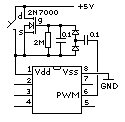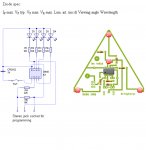Hi Steve,
Welcome to the forum. It might not be a good idea to try to follow up such an old (7 years) thread. I don't know if Ken is still active on the forum, and you are making an (IMHO incorrect) assumption that the method is appropriate for your project. Also, other members (and me) are not likely to want to plough through 44 previous posts concerning arguably "obsolete" components. The 08M has been superceded by the 08M2 and there are now "Logic Level" FETs available, which make the charge pump in the previous post generally unnecessary.
So what are your (or the project) requirements? In particular, what is the battery supply (voltage), how many and what specification are the LEDs, and must you use an 08M or can you use an 08M2? A diagram of your present circuit could be helpful.
However, IMHO all that the circuit probably needs is a Battery, PICaxe, LED(s), push-button, a cheap bipolar transistor (e.g. BC548 or BC337, etc.), a few resistors and, of course, a supply decoupling capacitor! But beware that a "toggle" acting pushbutton switch can be a programming challenge because of "contact bounce". An additional capacitor (across the pushbutton) might be a worthwhile addition. The PICaxe's SLEEP or NAP commands should be able to handle the low power requirement when "Off".
Cheers, Alan.


